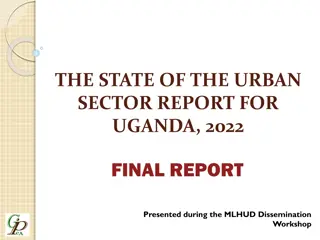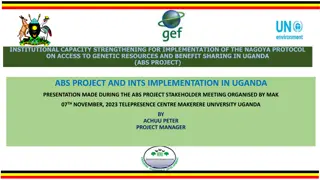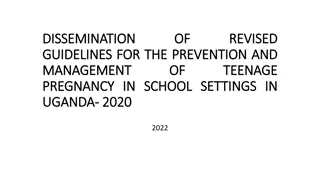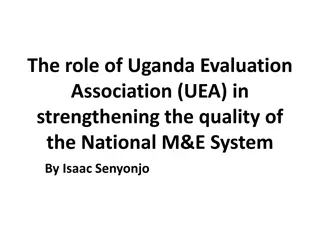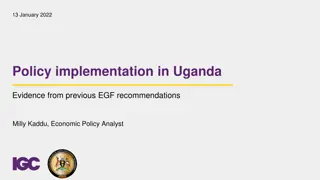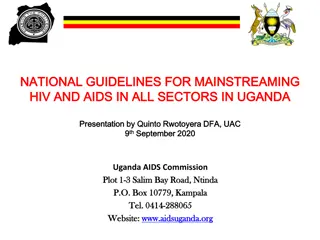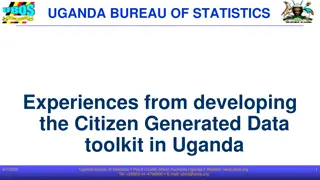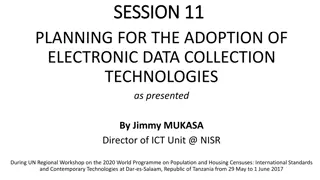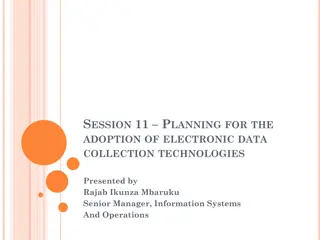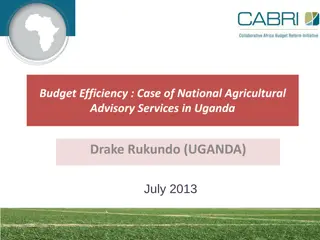Implementation of Electronic Data Collection Technologies in Uganda
Uganda Bureau of Statistics is utilizing electronic data collection technologies for census and surveys, including the use of handheld devices. The 2014 NPHC employed OCR/ICR scanning technologies. Plans are in place to incorporate hand-held devices for the 2024 NPHC to eliminate delays and improve efficiency.
Download Presentation

Please find below an Image/Link to download the presentation.
The content on the website is provided AS IS for your information and personal use only. It may not be sold, licensed, or shared on other websites without obtaining consent from the author.If you encounter any issues during the download, it is possible that the publisher has removed the file from their server.
You are allowed to download the files provided on this website for personal or commercial use, subject to the condition that they are used lawfully. All files are the property of their respective owners.
The content on the website is provided AS IS for your information and personal use only. It may not be sold, licensed, or shared on other websites without obtaining consent from the author.
E N D
Presentation Transcript
UGANDA BUREAU OF STATISTICS Use of electronic data collection technologies: main drivers and decision-making process and Use of handheld electronic devices for census data collection Prepared by: Uganda Bureau of Statistics SESRIC, Turkey, March 2019 1 Uganda Bureau of Statistics Plot 9 Colville Street, Kampala Uganda Website: www.ubos.org Tel: +256(0)- 414-706000 E-mail: ubos@ubos.org
Uganda Official Name: Republic of Uganda Official Language: English Total Area: 241,550 km2 Population: Census 2014: 34.6M 2018 Projection: 39M Population density: 173 /km2
Background Uganda has implemented 10 Population and Housing Censuses to date; No use of hand held devices has been carried out in NPHC; However tablets are being used in the large scale surveys Uganda Bureau of Statistics Plot 9 Colville Street, Kampala Uganda Website: www.ubos.org Tel: +256(0)-414-70600 E-mail: ubos@ubos.org
2014 NPHC The 2014 NPHC was a defacto census The 2014 NPHC employed OCR/ICR technologies in scanning questionnaires The first results of the NPHC 2014 were released after 1.5 years Uganda Bureau of Statistics Plot 9 Colville Street, Kampala Uganda Website: www.ubos.org Tel: +256(0)-414-70600 E-mail: ubos@ubos.org
Surveys Using Hand Held Devices Uganda National Household Survey 2016/17 Increased sample from 7500 HHds (2012/13) to 17,800 (2016/17) with minimal increase in budget ( received a donation of Tablets). Uganda Demographic and Heath Survey 2016 sample size of 19,600 households; National Labour force surveys Varies in sample size Planned Updating of master list of Education Institutions Uganda Bureau of Statistics Plot 9 Colville Street, Kampala Uganda Website: www.ubos.org Tel: +256(0)-414-70600 E-mail: ubos@ubos.org
Hand held devices in the 2024 NPHC CAPI will be used in 2024 NPHC data collection, the debate is to what extent Hybrid of CAPI and PAPI or only CAPI The decision to use CAPI based on the earlier censuses and the CAPI surveys Heavy integration of Geo-Spatial technologies Uganda Bureau of Statistics Plot 9 Colville Street, Kampala Uganda Website: www.ubos.org Tel: +256(0)-414-70600 E-mail: ubos@ubos.org
Why use of Hand held devices Elimination PAPI and associated delays in the release of results; Use of hand held devices enables real-time data storage using mobile equipment. Storage and transport costs are minimized CAPI has features which capture other data eg GPS co-ordinates, pictures, etc Uganda Bureau of Statistics Plot 9 Colville Street, Kampala Uganda Website: www.ubos.org Tel: +256(0)-414-70600 E-mail: ubos@ubos.org
Why use of Hand held devices Efficiency in handling of enumeration exercise Immediate error correction while still in household (skips and error messages) Faster backup and transfer of data; Improved quality control Uganda Bureau of Statistics Plot 9 Colville Street, Kampala Uganda Website: www.ubos.org Tel: +256(0)-414-70600 E-mail: ubos@ubos.org
Challenges of CAPI 1. Occasional loss of the Tablets. 2. Internet coverage in some areas is low or non- existent; 3. Need for replacement in case of the devices crash. 4. Power disruptions especially in rural areas 5. Extended period of Training of field staff since field staff are trained both on the Paper and CAPI 6. The need to have competent staff in each EA 7. Attitude change Uganda Bureau of Statistics Plot 9 Colville Street, Kampala Uganda Website: www.ubos.org Tel: +256(0)-414-70600 E-mail: ubos@ubos.org
Some considerations in planning 1. Sufficient Training for staff involved. 2. Efficiency of the system in data transfer and backups; 3. Pretest the system to ensure it is stable. 4. Security of the data 5. Automated saving Uganda Bureau of Statistics Plot 9 Colville Street, Kampala Uganda Website: www.ubos.org Tel: +256(0)-414-70600 E-mail: ubos@ubos.org
Conclusion 1. Use of hand held devices has several advantages over the PAPI; 2. Early planning is vital; 3. Capacity building of staff in the use of CAPI is one of the necessities for success; 4. Field supervision and follow up; Uganda Bureau of Statistics Plot 9 Colville Street, Kampala Uganda Website: www.ubos.org Tel: +256(0)-414-70600 E-mail: ubos@ubos.org
12/13/11 Uganda Bureau of Statistics Plot 9 Colville Street, Kampala Uganda Website: www.ubos.org
Uganda Bureau of Statistics Statistics House 9, Colville Street THANK YOU Kampala Tel: +256 414 706000 www.ubos.org Uganda Bureau of Statistics Plot 9 Colville Street, Kampala Uganda Website: www.ubos.org Tel: +256(0)-414-70600 E-mail: ubos@ubos.org




